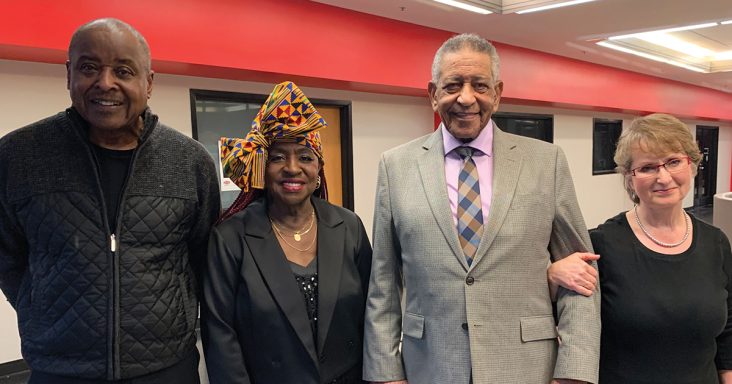A-State Museum documenting Jonesboro Black business history
by June 10, 2024 9:52 am 265 views

Leroy Johnson’s great-grandfather was 6 or 7 years old when he was bought as a slave and brought to Craighead County. Eventually he was freed and he engaged in a number of endeavors that included raising a family and working on a farm.
Johnson spent time with his great-grandfather while he was growing up in Bay in the 1940s. At this point the older man was in his 90s, but the two still chatted, Johnson told Talk Business & Politics. Curiosity got the best of Johnson once and he asked if “anything bad” happened while he was owned as a slave.
“I’ve forgotten those things,” the older man replied.
Slavery may have ended following the Civil War, but a new era of segregation swept the country in the decades that followed, said Arkansas State University Museum Education Curator Jill Kary. One result of this dynamic was the formation of all Black-owned business districts in many southern towns and cities.
Jonesboro had one that thrived until the 1960s, she said. The museum, along with residents such as Roger McKinney, are trying to catalogue many of the businesses in the district. More than 50 businesses have been identified that operated there through the 1960s.
“From the 1880s to the 1960s, segregation laws in Arkansas separated the races of Jonesboro,” Kary said. “Still, Black businesses, schools, and the brave African American community itself flourished. … There were many more businesses before 1900 that we are trying to document.”
The museum is working on an exhibit that will commemorate this largely forgotten piece of history, Kary said.
Throughout the years the number of Black-owned businesses has steadily grown, but still lags well behind the number of businesses owned by other ethnicities. According to the Pew Research Center there were an estimated 161,031 Black-owned or majority shares held firms in the U.S., up from 124,004 in 2017. Nearly 45,000 of those were in healthcare and social assistance sectors.
Revenues from these Black-owned businesses totaled $183.03 billion in 2021, a 43% uptick from 2017. The companies employed about 1.4 million workers and had combined payrolls of more than $56 billion.
Despite the numbers, only about 3% of U.S. businesses are Black-owned, while Black people make up more than 14% of the population. Georgia, Maryland and the District of Columbia have the most Black-owned businesses based on percentage. In each place, about 7% or more of businesses located there are Black-owned. In Arkansas, the percentage is 3% or less, according to Pew.
Jonesboro’s Black business District was along Washington Street, McKinney said. Barbershops, grocery stores, restaurants and even a hotel thrived during the 1950s when he was growing up, he said.
McKinney is the curator of the Craighead County-Jonesboro African American Cultural Center. The Center began in 1993 as a support organization, and it now is attempting to preserve as much African American history as it can, he added.
There were several notable businesses and business people that operated in the former Black business district in Jonesboro, according to the A-State museum. Nearly all were “mom and pop” owned businesses that vanished when the district declined, McKinney said. Fowler’s Grocery Store was located on Baker Street. Fowler’s would hire young black males to work in the store after school to earn money. Blake’s Fish Market was a notable specialty shop, the museum reported.
“The barber shop was an important business in the black community. It was the meeting place for the men and ministers in the community where they talked politics, religion, and social issues. There were approximately eight to 10 barber shops and many of the wives of the barbers operated beauty shops in their homes or next door to their husband’s barber shop. One of the most famous barber shops was owned by Mr. E. T. Kendall, located at 407 Baker St.” according to the museum.
Other important members of the community and businesses included doctors, mid-wives, funeral homes and boarding houses.
“Practicing physicians included Dr. Williamson, Dr. Ezell, Dr. Mundy, and Dr. Garbashine. Mid-wives assisted the doctors in delivering babies, and the families might barter with the mid-wives for eggs and chickens to pay for the deliveries. The business district also served the funeral needs of the Black community. Jones Funeral Home and Crumpler Funeral Home came to Jonesboro in 1946. Among other businesses of special note are the Masonic Lodge No. 114 that was located at 237 S. Main and Mrs. Harris Boarding House,” the museum reported.
Churches and schools played a key role in developing and maintaining the district through the years.
“The churches helped to establish commercial districts and community organizations to provide spiritual and political leadership in the communities. The Jonesboro African American community established several churches including St. John Baptist Church and Miller’s Temple COGIC on the north side and Carter’s Temple C.M.E., First Baptist Church, St. Paul A.M.E., First Baptist Church, and St. Paul Baptist Church.”
“Churches often also served as schools. African Americans valued education, but during segregation high school education was difficult to achieve. Booker T. Washington High School was highly regarded as a destination for learning and drew students from all over Arkansas,” according to the museum.
One person who has a strong personal tie to the former business district is Norma Ferrell. She grew up visiting the district and both her parents worked there. His dad shined shoes and worked as a porter. Her mother cleaned two floors of the local Citizens Bank.
Church, school, and the occasional visit to the district were rich parts of her childhood. Segregation was still prevalent until the school districts desegregated in 1967. She thinks the African-American community may have had a tighter bond that began to loosen as the district declined.
“I’m proud to have been part of the Black community in Jonesboro,” she said.
